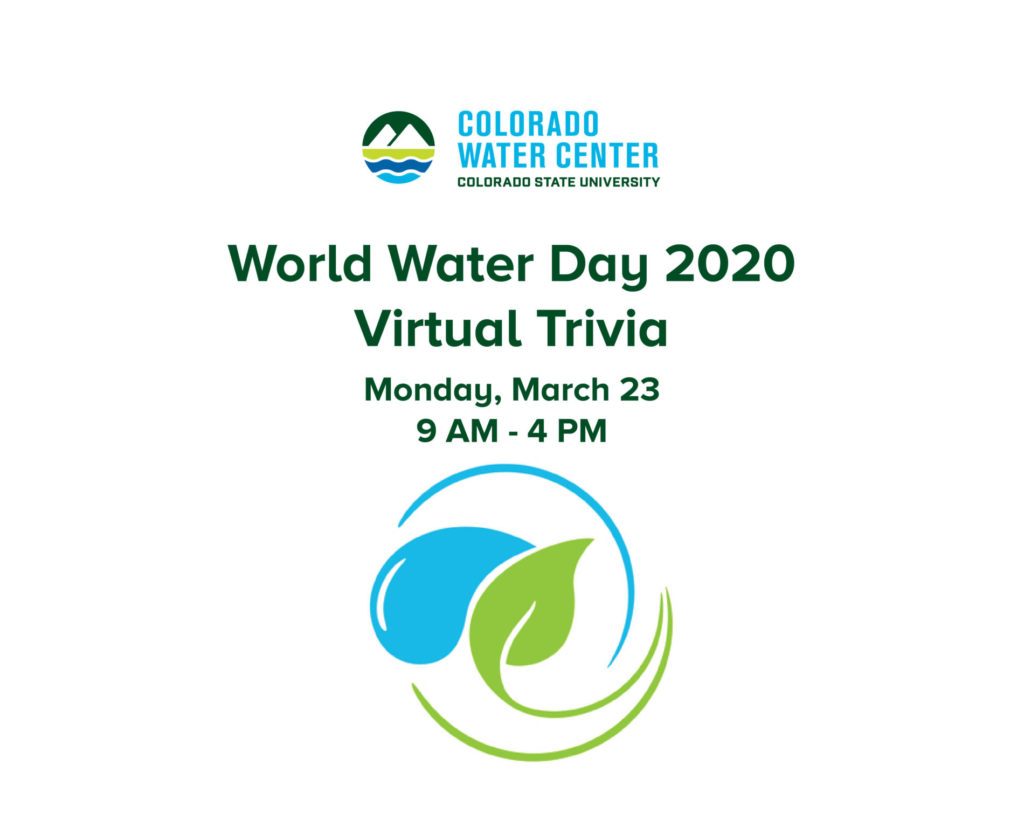World Water Day 2020
The CoWC World Water Day Trivia Game was hosted virtually on our Facebook and Twitter pages. Honoring the theme of climate change and water we shared resources from work published in our newsletter Colorado Water. An abundance of current water-related research necessarily addresses climate change while confronting local challenges. Questions also covered global topics.

World Water Day Trivia Game
Question 1
How many forested acres in Colorado have been impacted by beetle outbreaks over the last two decades?
Answer 1
“Historically severe and widespread mountain pine beetle and spruce beetle outbreaks have caused tree mortality across five million forested acres in Colorado over the last two decades”
Source: Effects of Forest Disturbance on Streamflow in Colorado, Colorado Water, January 2020
Authors: Abby Eurich, Paul Evangelista, Stephanie Kampf, Ecosystem, Science and Sustainability, Colorado State University; Tony Vorster, Brian Woodward, Graduate Degree Program in Ecology, Colorado State University; John Hammond, United States Geological Survey
Question 2
In Nicaragua, the “country of lakes and volcanoes,” what percentage of the population lacks access to “improved” or piped water sources?
Answer 2
“Nicaragua has abundant surface and underground freshwater, but over 30% of the population lacks access to “improved” or piped water sources. Moreover, many water sources suffer from contamination. This results from industrial processes, domestic uses, and natural occurrences of toxins like arsenic. Extreme storms and flooding also compromise water quality. Lastly, situated in one of the regions most vulnerable to global climate change, Nicaragua experiences climatic variation that is worsening its regular bouts of severe drought. All of this means that access to clean water for essential daily uses can be elusive.”
Source: Water Equity and the Pursuit of Justice, Colorado Water, January/February 2019
Authors: Sarah Romano, Political Science and Global Studies, Lesley University
Question 3
What are extreme cities?
Answer 3
“Extreme cities are urban environments that exhibit stark economic and environmental inequality. Access to clean water is often a challenge in these places, as are the threats of flooding and drought. The Secondary Cities Initiative works to better understand extreme cities and uses open-source geospatial technologies to collect data on these unique environments…”
Source: Mapping Extreme Cities The Quest for Effective Water Data, Colorado Water, March/April 2019
Authors: Melinda Laituri, Ecosystem Science and Sustainability and Geospatial Centroid, Colorado State University
Question 4
What is an atmospheric river?
Answer 4
“The American Meteorological Society Glossary defines an atmospheric river as “a long, narrow, and transient corridor of strong horizontal water vapor transport.” It goes on to explain that these rivers are responsible for large precipitation events when forced over mountain barriers like the Colorado Rockies.”
[2018] was both the hottest and driest water year on record for Colorado west of the Continental Divide. 2019 on the other hand, was the wettest cold season in western Colorado since 1980.”
Source: 2019 A Snow Year to Remember for Western Colorado, Colorado Water, August 2019
Authors: Peter E. Goble and Russ S. Schumacher Colorado Climate Center, Colorado State University
Question 5
Treating and re-using wastewater is an effective way to save water. Approximately how much wastewater is currently not treated and/or re-used globally?
a. 78%
b. 80%
c. 83%
Answer 5
About 80% of wastewater is currently not treated and/or re-used globally.
Source: International World Water Day Publishing
Question 6
By 2040, the global demand for water is expected to increase by at least what?
a. 25%
b. 37%
c. 50%
Answer 6
The global demand for water is expected to increase by at least 50%.
Source: International World Water Day Publishing
Question 7
What sector uses the most water globally and what percentage of global water withdrawals does it account for?
Answer 7
Agriculture diverts the majority of water, accounting for around 70% of global water withdrawals.
Source: Food and Agriculture Organization of the United Nations
Question 8
Conserving and restoring mangrove habitats is one nature-based solution to climate challenges.
How many tons of carbon do the earth’s mangroves hold?
Answer 8
Mangrove soils hold about 6 billion tons of carbon and can sequester up to three or four times more carbon than their terrestrial counterparts.
Source: United Nations Water Policy Brief on Climate Change and Water
